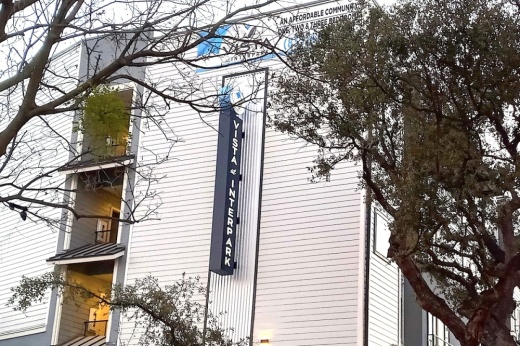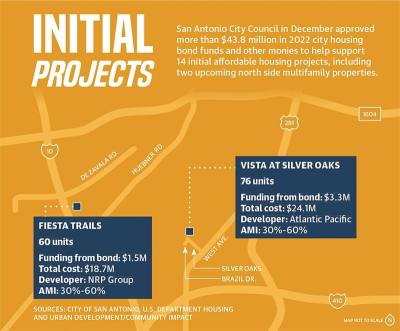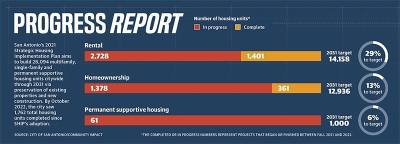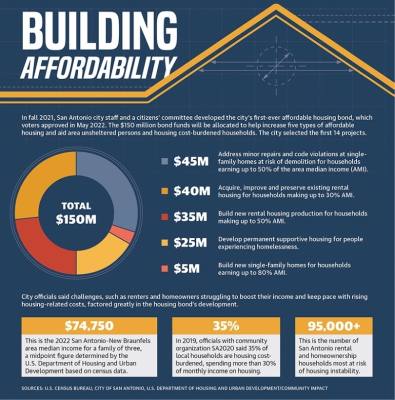The city of San Antonio is working with for-profit and nonprofit partners to implement a $150 million, five-year housing bond, which local leaders and housing advocates said is a big part of long-term efforts to increase affordable housing.
The city cited a need to aid an estimated 95,000-plus residents struggling to obtain or remain in a safe, affordable home amid rising housing costs.
San Antonio City Council on Dec. 15 approved a total of $38.5 million in housing bond proceeds and $5.31 million in various federal monies for 14 initial affordable housing projects citywide, including two new north side apartment complexes. The housing bond was part of the city’s voter-approved $1.2 billion bond in May 2022.
City leaders, including Mayor Ron Nirenberg, said the housing bond complements the city’s 2021 Strategic Housing Implementation Plan and other long-range housing initiatives designed to grow the number of local inexpensive housing options for both unsheltered persons and what the city calls “housing cost-burdened residents.”
According to U.S. Census Bureau data, 35% of local households were housing cost burdened in 2019, meaning those homeowners or renters spend more than 30% of their monthly income on a mortgage or rent.
“This direct investment in affordable housing will considerably boost local housing supply, preserve our aging housing stock, protect our neighborhoods and will help ensure that everyone has a place to call home,” Nirenberg said.
Defining affordability
San Antonio’s Neighborhood and Housing Services Department defines affordable housing as inexpensive and varied housing options dedicated to renters earning up to 60% of the San Antonio-New Braunfels area median income, or AMI, and homeowners making up to 120% of the AMI.
The U.S. Department of Housing and Urban Development uses local income ranges to generate an AMI number each summer. As of Feb. 1, the local AMI is $74,700 for a three-person household, HUD officials said.
Local officials said they developed the housing bond to supplement the SHIP, which the council adopted in 2021 with an aim of producing 28,094 total single-family and multifamily housing units citywide through 2031 through preservation and improvement of existing properties and new development.
“This is a longstanding mission that won’t get done overnight. It’s going to take at least 10 years to do this,” city Chief Housing Officer Mark Carmona said.
City officials said as of Feb. 1, approximately 1,401 rental units and 361 homeowner units had been completed with more than 4,100 affordable housing units under construction or in planning.
Housing bond basics
Some of the projects under development are included among the initial projects receiving housing bond proceeds. City officials said they partnered with housing organizations and citizens’ bond committee members to review and score 29 total responses to separate requests for proposals, or RFPs, addressing three of five overriding objectives outlined in the bond.
City officials said approved and upcoming housing bond projects are scored on various factors, such as cost, location and design, adding new construction projects are also analyzed for risk of displacing existing residents around the project site.
Ultimately, three RFP evaluation panels made 14 project recommendations for council approval. One recommendation was for $19 million to build five new rental communities; this money comes from $35 million the bond dedicated for new local rental housing priced for households earning up to 50% of the AMI.
One RFP review panel recommended more than $19.9 million in bond funds for another six projects from the $40 million made available for acquiring, rehabilitating and preserving existing apartment properties. These projects will be priced for households earning up to 30% of AMI.
A third panel recommended three projects receive $4.82 million from $5 million the bond provides to build new single-family houses for homeownership. These homes will be priced for households earning up to 80% of AMI.
The council’s vote Dec. 15 directed more than $43.9 million in bond funds and federal monies to the first 14 projects, which will add or preserve 2,532 units, including 2,461 rental and 71 homeownership opportunities.
According to city officials, the housing bond also added $45 million to existing city programs that help eligible homeowners address structural repairs and code compliance issues to stave off risk of demolition and stay in place. Such residents must be making up to 50% of AMI, city officials said.
The housing bond allotted a final $25 million to subsidize affordable housing with permanent on-site services to support people experiencing homelessness.
A citywide challenge
Local government officials and housing advocates said the housing bond and the SHIP both demonstrate their push to bolster housing affordability in various neighborhoods.
Ed Hinojosa, president and CEO of Opportunity Home—formerly the San Antonio Housing Authority—voiced support for boosting different types of affordable housing in all parts of town.
Hinojosa said COVID-19’s economic effects, including job losses, business disruptions, rental evictions and home foreclosures, have compounded housing affordability issues. He said his organization’s waitlist for local affordable housing rose from 35,000 in 2019 to 70,000 in early 2023.
“Rent has increased 15% to 20% in many locations across the nation. The actual cost for people wanting to buy a home is increasing. The price of real estate has gone up. All of those factors combined have contributed to a growing awareness of the need for housing that’s affordable,” Hinojosa said.
Although 12 of the first 14 projects launching under the affordable housing bond are in older neighborhoods primarily inside Loop 410, two of the projects—Fiesta Trails and Vista at Silver Oaks—will be built between Loop 410 and Loop 1604 and east of US 281.
Opportunity Home is partnering with Florida developer Atlantic Pacific to build the 76-unit Vista at Silver Oaks Apartments near Silver Oaks and Brazil drives north of Castle Hills.
Costing $28 million, Vista at Silver Oaks received $3.3 million in bond proceeds and will be priced for households earning 30%-60% of AMI, according to Opportunity Home officials.
Jessica Wade Pfeffer, Atlantic Pacific public relations representative, said the Vista at Silver Oaks location offers residents quick access to transit, grocery stores, pharmacies, medical care, employment, schools, parks and recreational amenities. She also cited a shortage of high-quality affordable housing options citywide, including the north side.
“The city has shown incredible leadership as they work to address the city’s affordable housing shortage in today’s challenging inflationary environment,” Pfeffer said.
She added construction on Vista at Silver Oaks could begin this April.
Opportunity Home is partnering with Cleveland-based developer NRP Group to construct the 60-unit Fiesta Trails Apartments on an undeveloped tract along West I-10 between Huebner and DeZavala roads.
At a cost of $18.7 million, Fiesta Trails received $1.5 million in bond funds and will be priced for households making 30%-60% of AMI, according to Opportunity Home officials.
District 8 Council Member Manny Pelaez said Fiesta Trails would positively benefit the area, adding the housing bond supports types of projects that may help dispel some negative perceptions about affordable housing.
“That’s an image perpetrated by irresponsible movies and TV shows,” Pelaez said. “Projects like Fiesta Trails work. These places are quite beautiful and bring panache to the surrounding neighborhood.”
Aiding the homeless
Katie Vela, executive director of local nonprofit the South Alamo Regional Alliance for the Homeless, said her organization, the city, and their public- and private-sector partners must do all they can to encourage more affordable housing citywide.
This, Vela said, includes connecting unsheltered persons to housing options with on-site supportive services, including health care, job placement, education, and substance use and family violence counseling, meant to help those persons stay in a safe, reliable home and improve their quality of life.
Vela said COVID-19’s effects are among many socioeconomic challenges exacerbating homelessness. The SARAH count of the local homeless population in early 2022 found 2,995 unsheltered individuals citywide, Vela said.
“No one organization can have the full impact on the homelessness that we’re dealing with,” Vela said.
The city began soliciting a second round of housing bond projects Feb. 3 with proposals due March 20, said Ian Benavidez, the city’s neighborhood and housing services deputy director.
“We’re especially emphasizing preserving existing housing. We know, for many people, the most affordable housing is the one you’re in right now,” Benavidez said.








